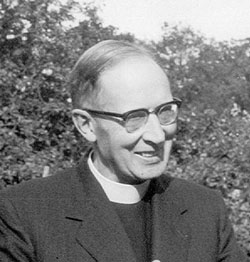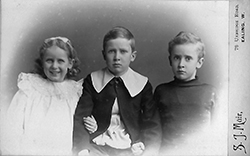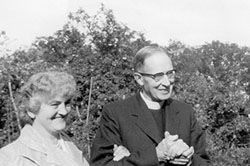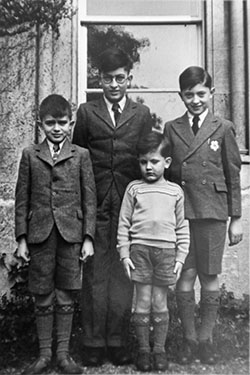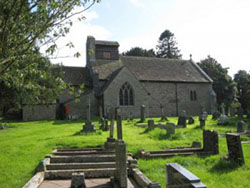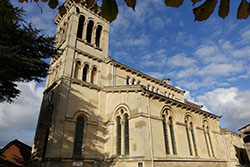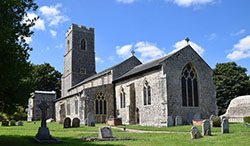The Rev. John Waddington HUBBARD MA BSc FRGS 1896 - 1988
First son, second child of Arthur John HUBBARD and Charlotte Marian VIZARD
Born 15th January 1896 - Hemel Hempstead, Hertfordshire.
Died 8th December 1988 - Worthing, Sussex. Buried at South Walsham, Norfolk.
Married Margaret Blanche SHEATH (1902-1980) 9th September 1933 at St Paul's Church, Canonbury, London N1
They had four sons
1 John Waddington Phillips HUBBARD 27 June 1934
2 Laurence Arthur HUBBARD 30 September 1936
3 David James HUBBARD 3 April 1940 - 21 Jan 1950
4 Michael Andrew HUBBARD 30 June 1943 - 3 Feb 2019
Known in the family as Jack.
Life Story
John was the eldest of the surviving children of Arthur John and Charlotte Marian (née Vizard). He was named after his grandfather who had died at a relatively early age in 1871.
He became known in the family as Jack but his clerical contemporaries knew him as John.
John went to a school in Ealing, West London and remained there when his parents retired to rural Gloucestershire in 1910. He did not have a good word to say for his school - despite this, however, he was an able pupil and gained entrance to Queens' College, Cambridge in 1913. He had completed his first year at Cambridge when the outbreak of the First World War supervened,
John had three siblings - George, Frances and Ben. His mother was 43 when Ben was born and, as sometimes it happens to older mothers, Ben had Down's Syndrome and, in the event, did not survive beyond his early forties.
George and Frances had all their wits about them but by temperament clashed from an early age. John held himself aloof from their squabbles and disputes. He and Frances got on very well together as did he and George.
First World War
As mentioned, the outbreak of war in 1914 interrupted John's studies at Cambridge. Like many others he volunteered for military service (conscription was not introduced until 1916).
He joined the Gloucestershire Regiment but subsequently was discharged on medical grounds because of a heart murmur (perhaps surprising as he went on to live until age 92). John then went to work in a munitions factory. He found it so stultifying boring that his father finally said to him: “Why don't you re-enlist in the army?” By now the demand for manpower was so great that he re-joined the army - this time he was commissioned into the Royal Army Service Corps and was posted to the Mediterranean Theatre in the Salonika Front under General Sir George Milne. As a Lieutenant his duty was to take charge of a detachment of lorries ferrying supplies from the port of Salonika in Greece to the frontline further north - Greece having joined the Allies in 1917. It was probably tedious and repetitive work because on one morning he was surprised to be woken up by the sound of church bells. He then realised that it was Easter Day 1918 and the bells of all the Greek Orthodox Churches were peeling in celebration. There must have been danger as well of course. John was mentioned in a despatch from Sir George Milne but, unfortunately, I do not know what act of bravery or resourcefulness gained him this recognition. John had a high opinion of the Army N.C.O.s whom he regarded as the backbone of the army. He was less impressed by the officer class. I do not know whether he was familiar with Siegfried Sassoon's description of British soldiers as lions led by donkeys, but I think that it might well have summed up his opinion of staff officers. John was demobilised in early 1919 and returned to his studies at Cambridge in autumn 1919.
His war experiences had affected his outlook on life and from reading theology he decided to read engineering or mechanical sciences as it was termed then. This meant that he had to condense three years' work into two including absorbing a lot of mathematics. He succeeded in this and took his B.A. degree in 1921. He then embarked on a career in engineering.
Engineering
After coming down from Cambridge in 1921 John commenced a career in engineering. He worked for a company called British Thomson Houston (BTH) in Rugby. BTH subsequently became part of General Electric.
John was to comment sardonically that polite society in Rugby at that time consisted of those in or connected with Rugby School - the rest of the population being plebs - to use an egregious modernism. He himself ran a motorbike which he used to visit his parents at weekends. About this time also he studied for an external degree at London University from which he gained a BSc. He thus had honours degrees from both Cambridge and London Universities.
His career then took him to the U.S.A.
[A passenger list records his arrival at Quebec, 11th November 1923, as an Electrical Student, onward to Schenectady, N.Y. state.]
This was the time of Prohibition and Chicago gangsters - although John worked in New England in the state of Connecticut. He admired the American "can-do" attitude but paradoxically found that it was an extremely bureaucratic society (perhaps this explains why there are so many lawyers there). It is interesting that many years later in the late 1950s he observed that cashiers in English banks serve at open counters whereas in America in the 1920s the bank cashiers worked behind bullet-proof screens. He forecast, however, that the time would come that British banks would also need bullet-proof screens and, of course, that did come about.
John also worked in India on various engineering projects. He was clearly highly proficient in his work.
On one occasion he recalled that he had been offered the job of chief engineer at the Colman Mustard factory in Norwich. He was met by a chauffeur-driven car at Norwich Thorpe railway station. In the event he did not take up the post. "They wanted me to re-organise the whole set-up," he said later, "but really there didn't seem to be much that needed improvement, so I didn't take the job." I believe that that was the only time that he had been to Norfolk before moving there many years later.
Ordination
Although highly successful as an engineer by the late 1920s John was beginning to feel that it was not as satisfying a way of life as he had originally hoped. He felt that he had a calling to the ordained ministry - a vocation that his mother had wanted for him nearly twenty years before. After further study at Ridley Hall in Cambridge he was ordained a deacon in the Church of England in 1928. He still wished to work abroad and was accepted by the Church Missionary Society for work in Nigeria (not India as he had expected). He was ordained to the priesthood in Nigeria in 1929.
Having given up a successful career as an engineer John at the age of 33 was in the ordained ministry working among the Isoko tribes people in the Niger Delta region. Clearly he made a deep impression on the people there. His son Laurence had occasion to visit the same area some fifty or sixty years later and met people who still remembered John. It must be remembered also that John had had a scientific training and he took the opportunity to survey and map many areas of the Niger Delta in detail - some for the first time. On returning home on leave in 1930 he was invited to give a presentation to the Royal Geographical Society in Kensington. He was elected a Life Fellow of the Society and thus could claim not only to have two University Degrees but also a Fellowship in a Learned Society. (Incidentally, there was a fee to pay to the R.G.S. which John's father paid on his behalf).
It was on his second tour of duty in Nigeria that John met Margaret Sheath who was also working for the Church Missionary Society in the town of Warri. They became engaged in June 1933 during a period of home leave and were married on 9th September 1933.
Marriage
Shortly after their wedding John and Margaret returned to Nigeria. By the end of the year Margaret was found to be pregnant and she returned to U.K. - childbirth in Nigeria for white mothers being considered to be neither safe nor appropriate. It was still considered to be the white man's grave. Thus began what from the standpoint of the present day appears to be an extraordinary period of separation. There were no phone, wireless or satellite means of communication between the Niger Delta and England. The sole means of communication was by letter (sea mail) which took six weeks to arrive. It seems that C.M.S. would not vary the terms of John's contract and as a result it was not until their child was nearly a year old that John and Margaret were re-united. For Margaret the separation although unpleasant was bearable. She had a baby to care for and the support of her brother who, for a time, shared a cottage she had rented in Seer Green in Buckinghamshire. In addition, her own parents were not far away in London.
For John, however, the separation led to almost unbearable loneliness. By his own admission he gradually became introspective and withdrawn. He was also to recount later a rather strange experience. On one morning in February 1935 he awoke with a strong feeling of premonition and dread. It was not until six weeks later that he was to learn that it was the day on which his father had died. John was subsequently diagnosed as suffering from neurasthenia (not I believe a diagnosis generally in use nowadays). The dictionary defines it as a type of nervous debility.
The Church of England
Upon his return to U.K. John left C.M.S. but, of course, needed a job (presumably a job which also for the time being would not be unduly onerous). In the event he took a country parish in rural Herefordshire. Things, however, are not always straightforward. It was here that John came up against the strange even arcane financial arrangements which presented themselves in the Church of England. As incumbent of the Parish of Cusop (near Hay-on-Wye,) John was entitled to the income of the benefice as his stipend. There was, however, a charge on the income. One-third was reserved to provide a pension for his predecessor. John thus only got two-thirds of what should have been his pay.
We have seen how his war experiences caused him to have a low opinion of army staff officers. He seems nearly twenty years on to have had a poor opinion of the then Archbishop of Canterbury whom he regarded as completely out of touch with the ordinary parson in the parish. The Archbishop, Cosmo Gordon Lang came from an aristocratic family and indeed had the reputation of being haughty and pompous. In Lang's defence it should perhaps be stated that during 1936 he became increasingly perturbed by the dysfunctional behaviour of Edward VIII and his role in engineering the abdication of that monarch turned out to be for the best.
By the middle of 1938 John and Margaret had two children. They decided to move from Cusop and John took a parish in Saint Albans in Hertfordshire.
A Slight Digression
Family holidays had always been a feature of Margaret's family. The 1920's saw a large expansion of private motoring and Margaret's father James Sheath was an enthusiastic motorist. He and Blanche enjoyed motoring holidays. Favoured places for their family holidays included Broadstairs on the Kent coast, Worthing and the Isle of Wight. It was in Worthing in Ambrose Place that James’s sister named Easter lived. Easter was Margaret's favourite aunt and she encouraged Margaret in all her undertakings. John and Margaret continued the tradition of family holidays by or near the sea. They went to the Isle of Wight in summer 1938 about the time that they moved to St. Albans. They planned only to stay five years in St Albans but the outbreak of WW2 frustrated this. It was about six months after the outbreak of war that John's mother Charlotte Marian (nee Vizard) died at the age of 81. Charlotte was a woman of strong character of whom Margaret was somewhat in awe. As a young woman Charlotte had been a nursing sister and one imagines ran her ward with an accent on discipline and good order. It was here in Hemel Hempstead that she met her future husband Arthur who was a GP in practice in the town. They married in 1888. Her first pregnancy and childbirth were difficult and, indeed, it seems life-threatening. Arthur became impatient with her doctor, sacked him and himself (contrary to usual medical norms) took over as her doctor. It proved to be a wise decision. Their child did not survive but Charlotte pulled through. Thereafter she idolised her husband. Any achievements that their children were subsequently to reach were as nothing in her eyes compared with their father's.
St. Albans did not suffer from Nazi bombing during the war. The nearest bomb fell in a potato field about a mile and a half outside the city. The glare from the fires in the East End of London could, however, be seen in the south-east sky. In addition to being the vicar of the Parish of Christchurch John was also chaplain of the workhouse called Oster House. From time to time inmates of the workhouse would be despatched to walk the mile or so to the Vicarage with some message or other. (It is not clear to me why these messages were not sent by telephone - perhaps it was thought that the inmates required exercise or some sort of purpose). After the end of the war with the advent of the Welfare State Oster House was re-named Oster Hills and re-designated as a hospital. In addition the name of its road was changed from Union Lane to Normandy Road. (The significance of the name Union derives from the fact that under Victorian Poor Law legislation parishes were required to provide for their indigent inhabitants and in order to cut costs they would often club together to provide one workhouse to cover a much larger area. In popular parlance the workhouse became the Union).
Having lived in Saint Albans throughout the war John and Margaret were anxious for a move. Emigration to South Africa was even mooted but did not come to anything ~ probably just as well as the policy of apartheid was introduced there in the late 1940s and such policy would have been abhorrent to them. In the event John was offered the living of South Walsham, Saint Mary and Saint Lawrence in the county of Norfolk to which they moved in November 1948. The patrons of this living were his old college Queens' College Cambridge. These days clergy stipends are standardised but back then they varied according to the endowments of the particular parish. John, in fact, got a considerable pay rise ~ no doubt fortunately as his family would have been getting to their most expensive stage.
Before this move in 1946 John acquired a car. It was a ten-year old Morris 8. There is a tendency to glamourise old classic cars. There was, however, no glamour in this car. Its interior was sparse and confined - moreover it lacked a boot, having instead a rudimentary metal rack at the back... but it was wheels and took the family on holiday. The first journey of note was to Dorset in October 1946 to the wedding of John's younger brother George to Mollie Buckett.
Not Hollywood glamour perhaps but a memorable occasion - the bridal car was a Rolls-Royce and the journey down included a night at the White Hart Hotel in Salisbury. Ballpoint pens had just become available and one of the bridal presents was a Biro pen - a mere trifle now but then an object costing 36 shillings and yielding pride of possession. The equivalent cost now is hard to quantify but probably of the order of £100/£200.
John and Margaret had been at South Walsham for little more than a year when tragedy struck their family. Their third son, David died on 21st January 1950 as a result of an accident at home - flammable clothing and an unguarded electric bar heater being a lethal combination. Despite their grief John and Margaret pulled their life together and went on to spend a further thirteen years at South Walsham - among the highlights of this period was the wedding in Saint Mary's South Walsham of their eldest son John to Nancy in 1959. In 1963 John was by now 67 years of age - but expecting to carry on working for another three years.
Margaret - herself aged 60 had had, however, enough of Rectory life. She felt that she was continually in the public eye as it were. Without too much difficulty she persuaded John that he should retire from his parish duties. They had sufficient capital to purchase a newly-built chalet bungalow in the village of Blofield some six miles from South Walsham with the advantage of a bus stop just outside their door with a convenient service into Norwich. Having travelled extensively in his younger days John no longer had any interest in foreign travel but Margaret enjoyed several years of holidays abroad with their youngest son Michael.
John and Margaret were to spend seventeen years of happy retirement in Blofield. Margaret had, however suffered from hypertension over many years and at the funeral service of her brother Laurie Sheath in January 1980 she seemed tired and drawn. A few weeks later she suffered a heart attack from which she rallied for a while. She was able to greet her grandchildren on Easter Monday but a second coronary in the early hours of the following morning proved to be fatal. She was buried a few days later in the graveyard at South Walsham.
Last Years
John was devastated by Margaret's death. He had, as he put it, "lost his life's partner." With the support, however, of his family and drawing on his inner reserves of stoicism he survived. In 1982 he moved to Worthing - firstly to Ramsay Hall (a clergy retirement home) and subsequently to Larkspur Nursing Home in High Salvington. From his window there he had a view across Worthing to the English Channel. He remained gently active until his ninetieth birthday and beyond. He read a passage from Scripture every day and meticulous as he always was he kept a daily record of this.
This record came to an abrupt end in mid-November 1988. Severe pain in his joints rendered him bedridden but he slipped away peacefully in the late afternoon of December 8th, 1988 - just six weeks short of what would have been his 93rd birthday.
John was the oldest member of his family for over a hundred years. His great-grandmother Anne Evans (née Dickinson) had died in 1883 at the age of 92. His sister-in-law Mollie was subsequently to live to a similar age as did Agatha Walker a more distant cousin.
After a simple funeral service in West Tarring Parish Church, John was interred in the same grave as Margaret in South Walsham Cemetery.
Weltanschauung
This short record makes clear how much his wife and family meant to him but what of his world-view (the nearest English rendering of the German Weltanschauung and a term he uses in his unpublished monograph Science and Religion: Is it peace?)
He was clearly a man of faith. In his churchmanship he was a conservative evangelical (an Open Evangelical in today’s understanding) but this was coupled with an independent lively and enquiring mind. As someone with a scientific as well as a theological training he was particularly interested in the interface between the Darwinian theory of evolution and the early chapters of Genesis. John was not particularly enamoured of the Roman Catholic Church, but it is probably true to say that he could identify with some aspects of Thomism (i.e., the philosophy of Saint Thomas Aquinas) in that reason properly applied can be relied on but that certain beliefs and doctrines (e.g., of the Trinity) can only be apprehended by revelation.
Above all John was fair-minded and an optimist. He believed that humankind could and would realise its full potential in the next life.
Written by his son, John Waddington Phillips HUBBARD 2013
Nick visits his Uncle Jack, and gets a metaphorical thick-ear.
It’s 1973, I’m 16 years and I know everything. My parents had had enough of telling my siblings what to do for a career, but it was now time for my “guidance”.
“No, I do not want 6th form, or go to university!”
“Visit your Uncle Jack!” father suggested.
An epic bus trip from Northampton to Norwich via Cambridge. No problem I was quite confident traveling. (London and grubbing around war-surplus radios was a regular event.)
Uncle Jack and Auntie Margaret were kind and tolerant. No conversion of their heathen nephew was attempted.
“Where are you sister and fiancé living?” Uncle Jack enquired.
“Together!” came my terse reply.
I detected a shudder.
We spoke of things engineering. UHF lecher lines. Silver plated rods in televisions.
“Dead shorts, surely?” probed my uncle. “But with weak signal voltages across them – so how do they work?”
"Resonant circuit."
“OK, now think of North America with power lines crossing the continent, then an engineer switches in a different power line. What happens?”
"I don't know!"
“Intermittent destruction of switching equipment! That's the same thing - resonance. That’s what I was investigating in the 1920’s.”
OK Perhaps I didn’t know everything. Studying City and Guilds telecommunications and finally getting to university when I was 30. Now I’m happy to say I know diddly-squat!
Margaret and Jack
David, John, Michael, Laurence
Cusop, Herefordshire
Christ Church, St Albans
South Walsham, Norfolk
